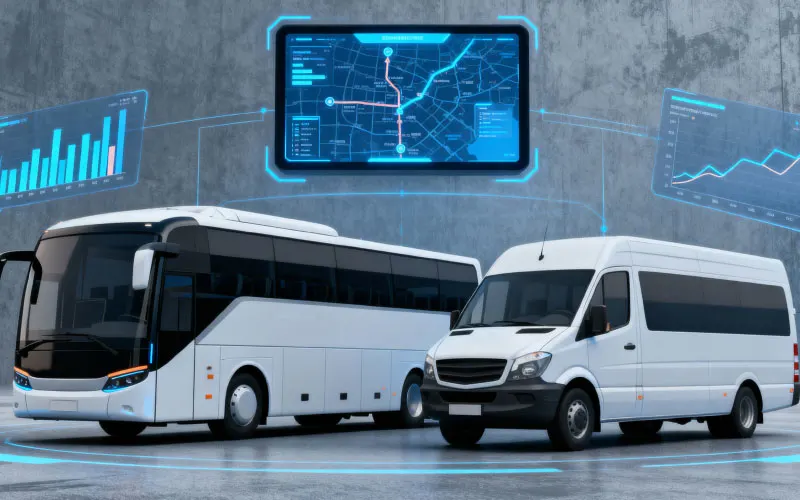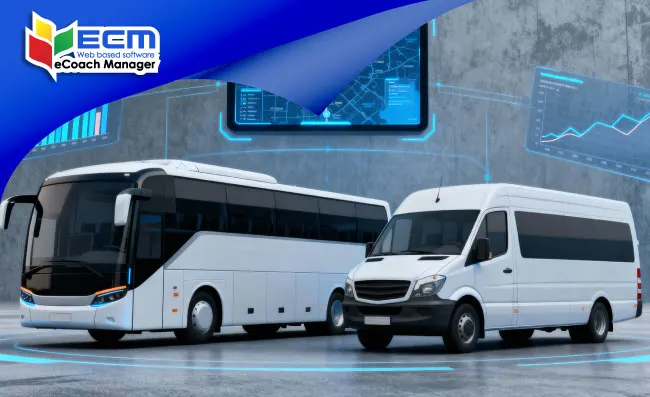Why Fleet Management is Changing Fast
The transport industry is undergoing a rapid transformation, fuelled by advancements in digital technology, heightened environmental awareness, and shifting customer expectations. What once revolved around simple vehicle tracking and maintenance schedules has now evolved into a highly sophisticated ecosystem that integrates AI-driven analytics, real-time monitoring, and sustainable solutions.
Fleet managers today face mounting pressures to reduce costs, enhance efficiency, improve safety, and meet sustainability targets. Companies that embrace modern fleet management practices are seeing substantial benefits, with studies reporting a 27% increase in operational efficiency for those adopting digital management platforms.
This article explores the seven most important trends in transport fleet management for 2025, providing actionable insights for businesses, fleet operators, and decision-makers who want to future-proof their operations.
Digital Transformation in Fleet Operations
Digitalisation is arguably the biggest driver of transformation in fleet management. By moving away from manual systems and legacy software, companies are unlocking a new level of visibility and control.
Cloud-Based Fleet Management Systems
Cloud-based platforms allow fleets to operate seamlessly across multiple regions. They centralise data storage, making it easier for managers to track vehicles, monitor compliance, and optimise performance from a single dashboard. Unlike traditional systems, cloud solutions offer:
- Scalability: From small fleets of five vans to enterprises managing 5,000+ vehicles.
- Accessibility: Remote logins allow managers to make real-time decisions, regardless of location.
- Integration: Compatibility with third-party apps, such as accounting software and HR systems.
Fleet companies adopting cloud systems also benefit from enhanced data security, as most providers include advanced encryption protocols and regular compliance updates.
Integration of IoT and Telematics
The Internet of Things (IoT) and telematics are transforming vehicles into connected data hubs. Sensors can now monitor fuel efficiency, tyre pressure, braking patterns, and even driver fatigue levels.
For fleet operators, this means:
- Lower fuel costs through real-time route optimisation.
- Improved safety by detecting and correcting dangerous driving behaviours.
- Predictive insights into vehicle health, reducing costly breakdowns.
IoT integration ensures that data is collected, analysed, and fed back into operational decision-making instantly. According to McKinsey, fleets using IoT-based solutions reduce operating costs by up to 15% annually (source).
Smart Routing and AI-Powered Optimisation
Routing has moved beyond static maps. Today’s systems leverage artificial intelligence and real-time analytics to deliver the most efficient paths possible.
Real-Time Data Analytics
Modern AI systems ingest data from GPS, weather forecasts, and traffic patterns to create dynamic, real-time routes. This allows fleets to avoid congestion, minimise idle time, and keep customers updated with accurate ETAs.
For logistics and passenger transport companies, time is money. AI-powered analytics reduce delays and enhance customer satisfaction—two factors that directly impact profitability.
Dynamic Route Adjustments
Gone are the days when drivers had to stick to pre-planned schedules. Now, systems can automatically reroute vehicles based on:
- Road closures and accidents.
- Customer delivery reschedules.
- Changing weather conditions.
Businesses using dynamic routing report fuel savings of up to 12% per year, while also lowering CO₂ emissions—an increasingly important KPI for corporate clients.

Sustainability and Green Fleet Initiatives
With governments tightening emissions standards, sustainability is no longer optional. Fleet managers must adopt green initiatives to remain compliant and competitive.
Electric and Hybrid Fleets
The shift to electric vehicles (EVs) and hybrid fleets is accelerating, particularly in urban areas where low-emission zones are becoming the norm. Benefits include:
- Reduced dependency on fossil fuels.
- Lower running costs over the vehicle lifecycle.
- Government incentives and tax benefits.
For example, the UK government’s plug-in van grant provides businesses with up to £5,000 in savings per EV purchase (source).
Carbon Tracking and Emissions Reporting
Corporate clients now expect transparent carbon reporting. Modern fleet management systems integrate carbon calculators, allowing businesses to monitor their environmental footprint in real time.
This is especially relevant for companies tendering for large government or corporate contracts, where sustainability is often a deciding factor.
Safety and Compliance Technology
Safety remains the cornerstone of successful fleet management. With rising insurance costs, stricter regulations, and heightened customer expectations, companies are increasingly turning to digital compliance and driver monitoring solutions to protect both passengers and cargo.
Driver Behaviour Monitoring
Telematics doesn’t just optimise fuel—it now plays a pivotal role in driver safety performance. Real-time data tracks:
- Speeding events.
- Harsh braking or acceleration.
- Seatbelt usage.
- Distracted driving behaviour.
Many companies adopt gamification techniques, rewarding drivers for safe practices and reducing risky behaviours. According to the National Highway Traffic Safety Administration (NHTSA), fleets that use telematics for driver behaviour monitoring have seen up to a 40% reduction in accidents.
Automated Compliance Tools
Compliance is no longer a paper-based checklist. Fleet management software integrates with government databases and regulations to automatically log driving hours, maintenance checks, and safety certifications.
Benefits include:
- Reduced administrative workload.
- Lower compliance risks (e.g., avoiding costly fines).
- Streamlined audits, since all records are digital and easily accessible.
By embedding compliance into daily operations, fleets can focus more on efficiency and service delivery while maintaining safety at the highest standard.
Cost Efficiency Through Predictive Maintenance
Reactive maintenance is expensive. Unexpected breakdowns not only delay operations but also damage customer trust. This is where predictive maintenance powered by AI is becoming a game-changer.
AI-Powered Maintenance Alerts
AI analyses vehicle sensor data to predict when parts will fail before issues occur. For example:
- Monitoring engine vibration patterns to forecast wear.
- Tracking tyre tread and pressure levels for replacement alerts.
- Detecting battery degradation in electric vehicles.
This proactive approach allows managers to schedule repairs when vehicles are off duty, minimising disruption.
Reducing Downtime and Extending Vehicle Life
Fleet downtime costs thousands per day. Predictive maintenance helps fleets:
- Cut maintenance costs by 25–30%.
- Increase asset lifespan by up to 20%.
- Enhance resale value by ensuring consistent service records.
According to Deloitte, companies adopting predictive maintenance strategies save an average of $17 million annually in downtime-related costs across large fleets.
Data-Driven Decision-Making in Fleet Management
In the modern era, data is the new fuel for fleet management. Companies that leverage data analytics can gain deep insights into their operations, enabling smarter and faster decisions.
Leveraging Big Data for Efficiency
Fleet managers can now analyse:
- Fuel consumption trends across different vehicle types.
- Driver efficiency comparisons, helping with targeted training.
- Route profitability, identifying high-cost and high-margin routes.
With this information, managers can allocate resources more effectively, aligning fleet operations with business goals.
Business Intelligence Dashboards
Visual dashboards bring data to life. Instead of scanning endless spreadsheets, managers can view:
- Real-time KPIs (e.g., cost per kilometre, fuel efficiency).
- Heatmaps showing high-demand areas.
- Automated reports for board presentations.
This empowers leadership teams to make strategic, evidence-backed decisions, improving profitability while keeping fleets competitive.
The Future: Autonomous and Connected Fleet Ecosystems
Looking ahead, fleet management is preparing for the next frontier: autonomous and connected vehicles. While widespread adoption may take time, early preparation ensures businesses remain competitive.
Preparing for Autonomous Vehicles
Companies like Tesla, Waymo, and Volvo are testing autonomous trucks and buses, with the potential to revolutionise logistics and passenger transport. Benefits include:
- Reduced labour costs.
- 24/7 operational capacity.
- Increased road safety by eliminating human error.
Forward-thinking fleet managers are already trialling semi-autonomous features like lane assistance, adaptive cruise control, and collision avoidance systems.
Connected Vehicle Networks
Vehicles are increasingly linked in digital ecosystems, sharing information with:
- Other vehicles (V2V).
- Traffic infrastructure (V2I).
- Logistics hubs and customer systems.
This creates a fully synchronised transport network, reducing congestion, optimising routes, and improving delivery accuracy. McKinsey predicts that by 2030, 95% of new vehicles will be connected to the internet, radically transforming fleet operations (source).
FAQs: Everything You Need to Know About Fleet Management Trends
- What is the biggest trend in fleet management for 2025?
The biggest trend is the digital transformation of fleet management systems, with AI, IoT, and cloud platforms leading the change. - How does predictive maintenance save money?
By forecasting issues before breakdowns, predictive maintenance reduces costly downtime, lowers repair expenses, and extends vehicle lifespan. - Why are electric vehicles important for fleets?
They reduce fuel costs, cut emissions, and help businesses meet strict sustainability regulations while improving brand reputation. - How do AI-powered routing systems work?
They analyse traffic, weather, and delivery schedules in real time to dynamically adjust routes, reducing delays and fuel consumption. - Are autonomous vehicles realistic for fleets today?
Fully autonomous fleets aren’t mainstream yet, but semi-autonomous features like adaptive cruise control and collision prevention are already in use. - How do compliance tools benefit transport companies?
Automated compliance systems reduce paperwork, ensure legal adherence, and simplify audits, helping companies avoid costly penalties.
Conclusion: Embracing the Future of Fleet Management
The transport fleet management landscape in 2025 is one of rapid digitalisation, sustainability-driven innovation, and data-powered efficiency. From AI-driven routing systems to predictive maintenance and autonomous ecosystems, these trends are reshaping the industry.
Companies that act now—embracing green fleets, investing in connected technologies, and leveraging real-time analytics—will not only cut costs but also gain a competitive advantage in an increasingly regulated, efficiency-driven market.
The future of fleet management isn’t just about moving vehicles. It’s about building smart, sustainable, and resilient transport networks that benefit businesses, communities, and the planet.

